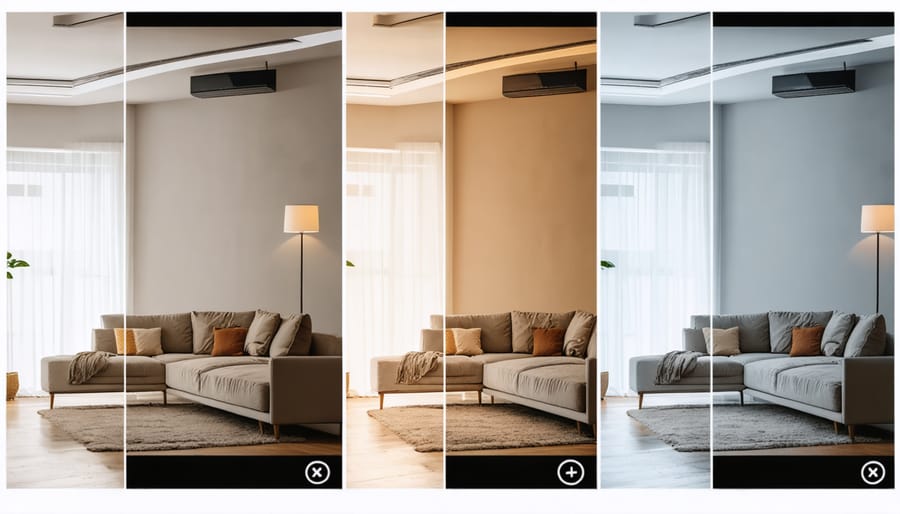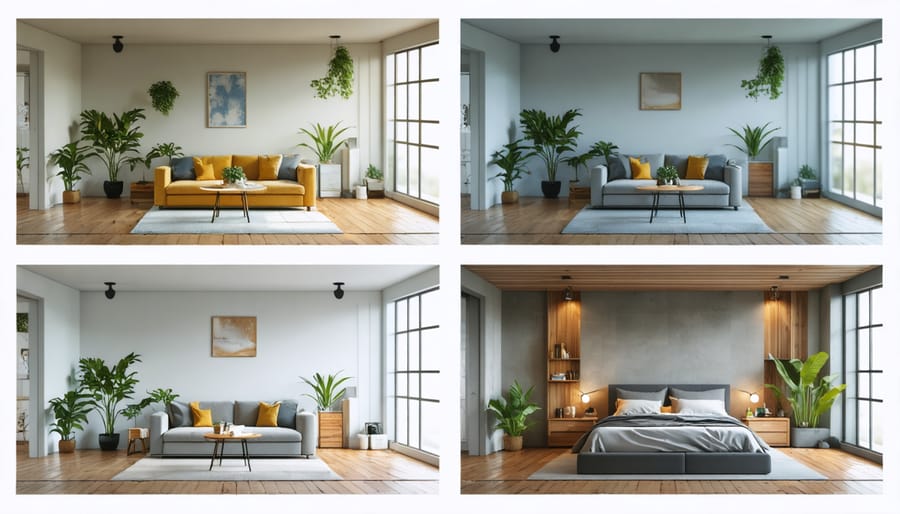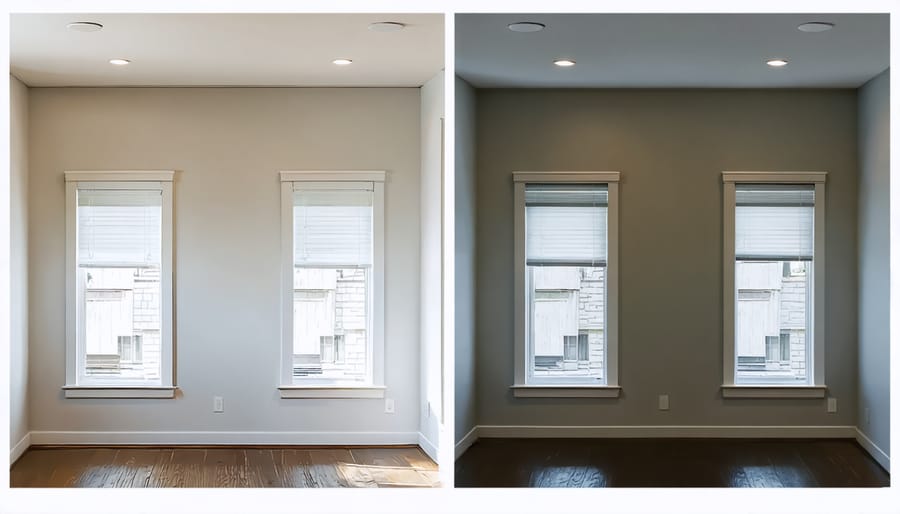Transform any room’s ambiance by mastering the three fundamental layers of lighting: ambient illumination for overall brightness, task lighting for specific activities, and accent lighting to create a cozy atmosphere. Position overhead lights 24-36 inches from walls to eliminate harsh shadows and maximize coverage across living spaces. Install dimmer switches to control light intensity throughout the day, adapting to natural light changes and different activities. Layer light sources at various heights—floor lamps at 60-72 inches, table lamps at 24-30 inches, and pendant lights at 30-36 inches above surfaces—to achieve balanced illumination that eliminates dark corners while maintaining visual interest. Consider color temperature carefully: use warm white (2700-3000K) in living areas and bedrooms, bright white (3500-4100K) in kitchens and home offices, and cool white (5000-6500K) in bathrooms and craft spaces for optimal functionality and comfort.

The Three Layers of Lighting Every Room Needs
Ambient Lighting: Setting the Base
Ambient lighting serves as your room’s foundation, creating an even wash of light that makes the space functional and welcoming. Think of it as your room’s “daylight” – it should provide enough illumination to navigate safely and perform basic tasks without causing glare or creating harsh shadows.
To achieve effective ambient lighting, start by calculating your room’s square footage and multiply it by 20 lumens per square foot for living spaces or 30 lumens for task-heavy areas like kitchens. This gives you a baseline for the total light output needed.
The best ambient lighting usually comes from ceiling-mounted fixtures, recessed lights, or wall sconces positioned around the room’s perimeter. Aim to space these fixtures evenly, typically 4-6 feet apart, ensuring light overlaps slightly to eliminate dark spots. For rooms with high ceilings, consider pendant lights or chandeliers that direct light both upward and downward.
Pro tip: Install dimmer switches for your ambient lighting. This simple addition lets you adjust the overall brightness throughout the day and create different moods for various activities.
Task Lighting: Function Meets Style
Task lighting is essential for activities that require focused illumination, like reading, cooking, or working from home. When you design the perfect workspace, proper task lighting can make all the difference in your productivity and eye comfort.
Consider adding adjustable desk lamps, under-cabinet lights in the kitchen, or swing-arm wall sconces beside your reading chair. These targeted light sources should be bright enough to prevent eye strain but positioned to avoid casting shadows on your work area.
For the best results, choose bulbs with a color temperature between 4000K and 5000K, which mimics natural daylight and helps maintain alertness. Don’t forget to include dimming options where possible – this allows you to adjust the brightness based on the time of day and specific tasks at hand.
Remember to position task lighting on your dominant side to prevent shadows when writing or working with tools. This simple adjustment can significantly improve your comfort and efficiency.
Accent Lighting: Adding Drama and Depth
Accent lighting is where you can really let your creativity shine! By strategically placing light sources like wall sconces, picture lights, or LED strips, you can transform ordinary spaces into stunning focal points. Try highlighting architectural features like exposed beams, archways, or textured walls to add depth and visual interest to your rooms.
For artwork, consider adjustable picture lights or track lighting that can be precisely aimed. The key is to illuminate without creating glare – position lights at a 30-degree angle for optimal effect. LED strip lights tucked behind crown molding or under cabinets can create a sophisticated ambient glow that adds dimension to your space.
Don’t forget about outdoor accent lighting! Use well lights to showcase beautiful landscaping or architectural details on your home’s exterior. Just remember to keep your accent lighting subtle – it should enhance your space’s features, not overwhelm them. A good rule of thumb is to use accent lighting that’s about three times brighter than the room’s ambient light.

Room-by-Room Lighting Solutions
Living Room Lighting Essentials
Your living room serves multiple purposes throughout the day, from morning coffee to evening entertainment, which is why a layered lighting approach is essential. Start with ambient lighting through a central ceiling fixture or recessed lights to provide overall illumination. This base layer should be dimmable to adjust the room’s brightness as needed.
Add task lighting for specific activities like reading or crafting. Table lamps beside seating areas and floor lamps near reading nooks create focused light where you need it most. For a cozy atmosphere, incorporate accent lighting through wall sconces or small accent lamps to highlight artwork or architectural features.
Consider the room’s natural light when planning your artificial lighting scheme. Place mirrors strategically to reflect and maximize daylight, and position task lighting away from windows to prevent glare. For optimal control, install separate switches for each lighting layer, allowing you to create different moods for various activities.
Remember to choose bulb temperatures thoughtfully – warm white (2700-3000K) creates an inviting atmosphere perfect for relaxation, while cooler temperatures work better for task-oriented activities.
Kitchen Lighting That Works
A well-lit kitchen combines both task and ambient lighting to create a functional and inviting space. Start with bright, even overhead lighting using recessed fixtures or a central pendant light. Under-cabinet lighting is essential for food prep areas, eliminating shadows on countertops where you’ll be chopping and cooking. Install these LED strips beneath upper cabinets for a clean, modern look.
Don’t forget about your sink area – a dedicated light fixture here prevents you from working in your own shadow. For islands or breakfast bars, pendant lights hung 30-36 inches above the surface provide both focused task lighting and visual interest.
Layer your lighting by incorporating accent lights to highlight architectural features or display areas. Dimmers are a must-have in the kitchen, allowing you to transition from bright task lighting for meal prep to softer ambient lighting for dining.
Consider color temperature too – opt for cooler, whiter lights (around 4000K) in prep areas for better visibility, and warmer tones (2700-3000K) in dining spaces for a cozier feel.
Bedroom Lighting for Comfort
Your bedroom should serve as a peaceful retreat, and lighting plays a crucial role in creating this sanctuary. Start with a central ceiling fixture that provides adequate general lighting, but make sure it’s dimmable to adjust the ambiance as needed. Place bedside lamps on both nightstands for balanced task lighting – ideal for reading or other bedtime activities.
Consider installing wall sconces as space-saving alternatives to table lamps, mounting them at eye level when seated in bed. For a luxurious touch, add subtle accent lighting like LED strips under the bed or behind the headboard for a soft, ambient glow.
Layer your lighting with different sources at varying heights to create flexibility throughout the day. Morning routines might require bright, energizing light, while evenings call for softer, warmer tones to help prepare your body for sleep. Use warm white bulbs (2700-3000K) to promote relaxation, and install separate switches for different light sources to create various moods.
Remember to position lights to minimize glare on screens and mirrors, and consider adding motion-sensor night lights for safe navigation during midnight trips to the bathroom.
Bathroom Lighting Done Right
Your bathroom lighting needs to serve two crucial purposes: helping you look your best during grooming tasks and creating a relaxing atmosphere for self-care routines. Start with a pair of wall-mounted sconces at eye level on either side of your mirror to eliminate unflattering shadows while applying makeup or shaving. This setup provides even facial illumination that overhead lighting alone can’t achieve.
For ambient lighting, consider recessed ceiling fixtures with a warm color temperature (around 2700K-3000K) to create a spa-like atmosphere. If your bathroom has a tub area, add a dimmable fixture above it for those relaxing soaks. Don’t forget about safety – ensure all fixtures are rated for wet areas and install them at appropriate distances from water sources.
For smaller bathrooms, a single ceiling-mounted fixture paired with vanity lighting might suffice. In larger spaces, layer your lighting with additional recessed lights or a decorative ceiling fixture. Remember to use frosted or diffused bulbs to minimize glare and choose fixtures with appropriate IP ratings for moisture protection.
Pro tip: Install your bathroom lights on separate switches so you can control task and ambient lighting independently, perfect for those early morning routines or evening relaxation sessions.
Common Lighting Mistakes and How to Fix Them

Avoiding Shadow Zones
Shadow zones can make a room feel gloomy and uninviting, but spotting and fixing these dark spots is easier than you might think. Start by doing a simple walkthrough of your space during different times of the day. Make note of areas where you struggle to read or perform tasks, as these are likely shadow zones.
Common shadow zones often appear in corners, under cabinets, and behind large furniture pieces. A helpful trick is to stand in various spots around the room and observe where light sources are blocked by objects or architectural features. Pay special attention to work areas, reading nooks, and spaces where you spend a lot of time.
To eliminate shadow zones, try implementing these effective solutions:
– Layer your lighting by combining different types of light sources
– Place floor or table lamps in dark corners
– Install under-cabinet lighting in kitchens and work areas
– Use wall sconces to fill gaps between ceiling fixtures
– Position mirrors strategically to reflect and bounce light
– Consider adding small accent lights behind furniture
Remember that not all shadows are bad – some create depth and ambiance. The goal is to eliminate uncomfortable dark spots while maintaining a balanced, welcoming atmosphere. If you’re still finding stubborn shadow zones, try rearranging furniture or adding portable lighting options before making permanent changes to your lighting setup.
Smart Fixture Placement
Strategic placement of light fixtures can make or break your room’s ambiance. Start by mapping your space and identifying key activity areas – these will be your primary lighting zones. For living rooms, position ceiling lights in the center for general illumination, then add wall sconces at eye level about 5-6 feet apart for balanced light distribution.
In your kitchen, install task lighting directly above work surfaces, typically 24-36 inches above countertops. Under-cabinet lighting should be positioned toward the front edge to prevent unwanted shadows. For dining areas, hang pendant lights 30-36 inches above the table surface for optimal illumination without blocking sightlines.
Bedroom lighting works best with a layered approach. Position your main light fixture in the center of the room, and add bedside lamps at roughly shoulder height when seated on the bed. For bathrooms, install vanity lights at eye level on both sides of the mirror rather than above it to minimize unflattering shadows.
Consider traffic patterns when placing floor lamps – they should illuminate walkways without becoming obstacles. When installing recessed lighting, follow the “4-foot rule”: space lights approximately 4 feet apart and 2 feet away from walls for even coverage. Remember to account for natural light sources and adjust artificial lighting accordingly to create a harmonious blend throughout the day.
For the best results, test your lighting plan using temporary fixtures before permanent installation. This allows you to fine-tune positions and identify any potential dark spots or glare issues.
Quick Tips for Better Lighting
Transform your space instantly with these practical lighting tips that anyone can implement. Start by maximizing natural light – clean your windows regularly and use light-colored, sheer curtains to let sunshine flood in. Position mirrors strategically across from windows to reflect light and help maximize your space.
Layer your lighting sources instead of relying on a single overhead light. Combine ambient lighting (general illumination) with task lighting (for specific activities) and accent lighting (to highlight features). Install dimmer switches where possible – they’re relatively inexpensive and offer incredible flexibility in controlling your room’s atmosphere.
Consider bulb temperature carefully. Warm white (2700-3000K) creates a cozy, intimate feel perfect for living rooms and bedrooms, while cool white (4000-5000K) works better in kitchens and home offices where task lighting is crucial.
Keep fixtures clean – dust-free bulbs shine 20% brighter! Replace old bulbs before they burn out, as their efficiency decreases significantly over time. When selecting new fixtures, choose light-colored or metallic finishes that reflect light better than dark materials.
Don’t forget about proper placement. Table lamps should sit at eye level when you’re seated, and pendant lights should hang 28-36 inches above a dining table. Avoid harsh shadows by placing task lighting slightly to the side of work areas rather than directly overhead.
Finally, use LED bulbs wherever possible – they last longer, use less energy, and now come in various warm tones that rival traditional incandescent bulbs for ambiance.
Mastering basic lighting design doesn’t have to be overwhelming or expensive. By understanding the three main types of lighting – ambient, task, and accent – and implementing them thoughtfully throughout your space, you can transform any room into a more functional and inviting environment. Remember to consider natural light as your foundation, layering artificial lighting to complement and enhance it throughout the day.
Start small by focusing on one room at a time, perhaps beginning with the space where you spend the most time. Experiment with different bulb types, temperatures, and positions until you find what works best for your needs. Don’t be afraid to mix lighting styles and sources – this layered approach is what creates depth and interest in your space.
As you apply these principles, you’ll notice how proper lighting can influence not just the functionality of your home but also your mood and well-being. Whether you’re reading, cooking, working, or relaxing, the right lighting setup will enhance every activity while creating a welcoming atmosphere for both family and guests.
Take the first step today by evaluating your current lighting and identifying areas for improvement. With these basic principles in mind, you’re well-equipped to create a beautifully lit home that serves both form and function.